Holmes Institute HI6006: Competitive Strategy Essay Analysis
VerifiedAdded on 2023/01/19
|6
|1882
|95
Essay
AI Summary
This essay provides a comprehensive analysis of competitive strategy development tools, focusing on their application within a business context. The essay begins by introducing strategy development tools and techniques, emphasizing their importance in managerial decision-making. It then delves into four significant tools: PESTEL analysis, Five Forces analysis, SWOT analysis, and generic strategies, illustrating how each tool can be used to evaluate a company's external and internal environments, assess its competitive position, and formulate effective strategies. The essay uses IKEA as a practical business example to demonstrate the application of these tools. The PESTEL analysis examines the political, economic, social, technological, environmental, and legal factors affecting IKEA. The Five Forces analysis assesses the competitive dynamics within the furniture retail industry. The SWOT analysis evaluates IKEA's strengths, weaknesses, opportunities, and threats. Finally, the essay explores IKEA's use of Porter's generic strategies, specifically cost leadership and differentiation. The essay concludes by highlighting the practical implications of these tools for strategic management and provides a list of references.
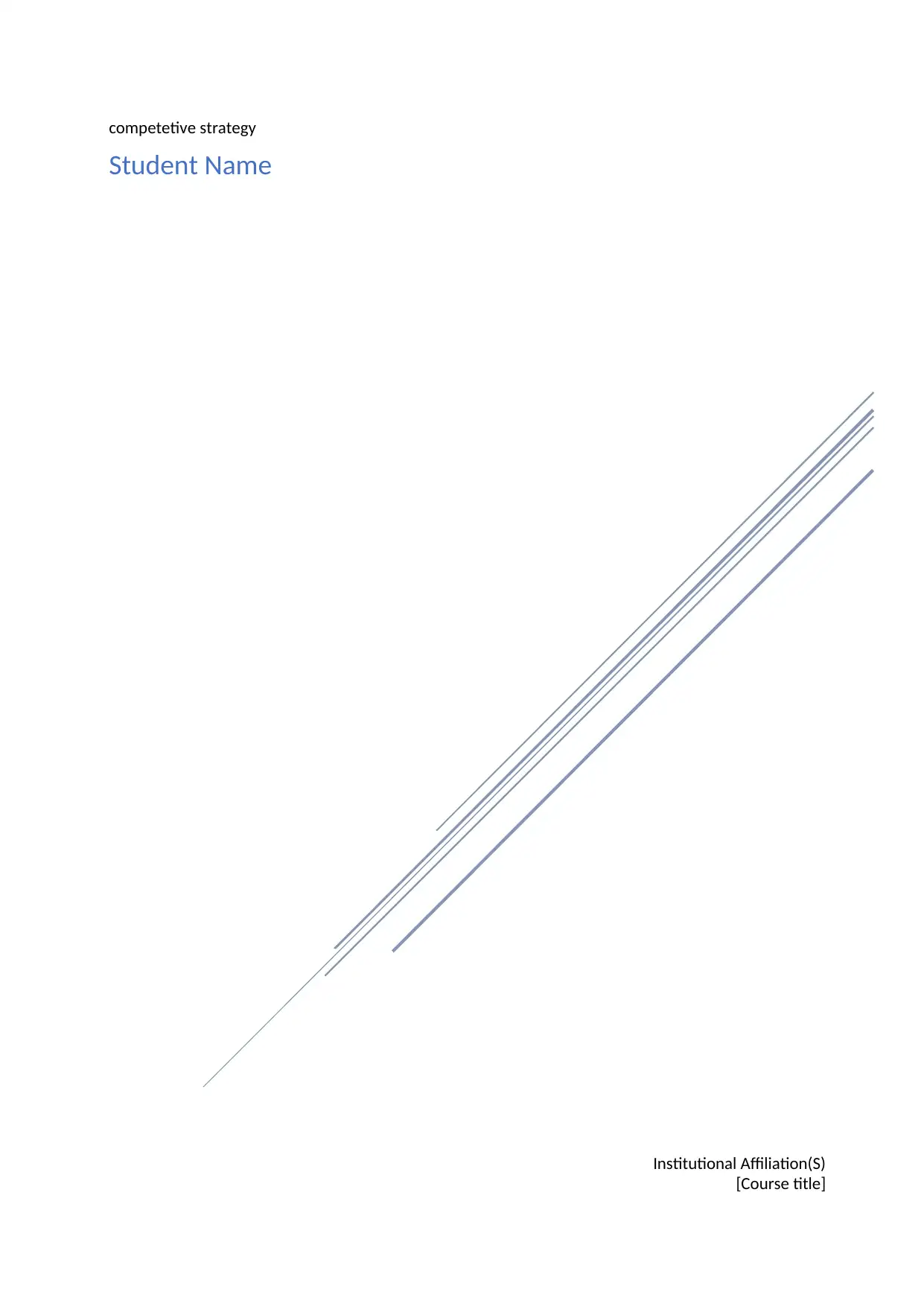
Institutional Affiliation(S)
[Course title]
competetive strategy
Student Name
[Course title]
competetive strategy
Student Name
Paraphrase This Document
Need a fresh take? Get an instant paraphrase of this document with our AI Paraphraser
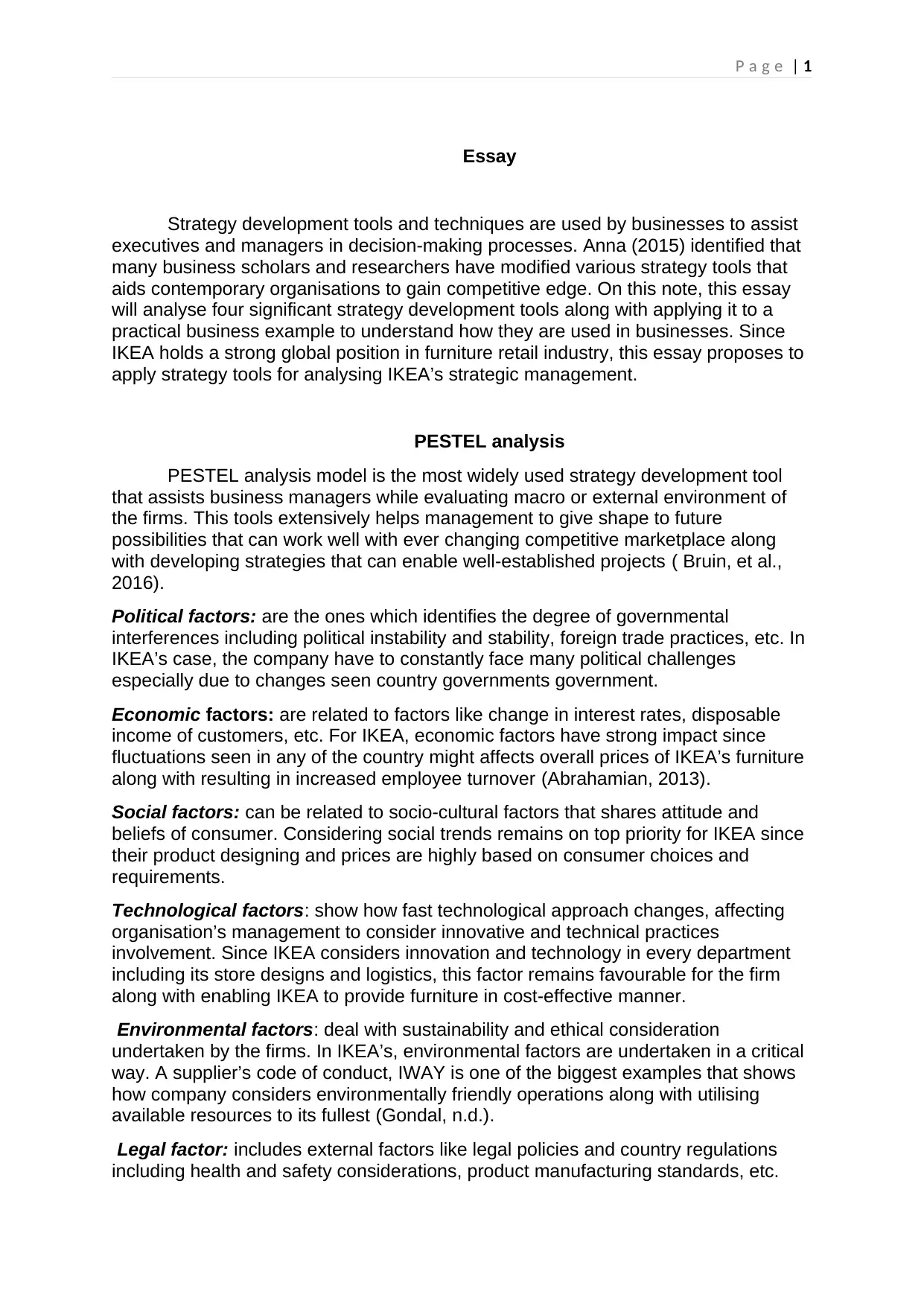
P a g e | 1
Essay
Strategy development tools and techniques are used by businesses to assist
executives and managers in decision-making processes. Anna (2015) identified that
many business scholars and researchers have modified various strategy tools that
aids contemporary organisations to gain competitive edge. On this note, this essay
will analyse four significant strategy development tools along with applying it to a
practical business example to understand how they are used in businesses. Since
IKEA holds a strong global position in furniture retail industry, this essay proposes to
apply strategy tools for analysing IKEA’s strategic management.
PESTEL analysis
PESTEL analysis model is the most widely used strategy development tool
that assists business managers while evaluating macro or external environment of
the firms. This tools extensively helps management to give shape to future
possibilities that can work well with ever changing competitive marketplace along
with developing strategies that can enable well-established projects ( Bruin, et al.,
2016).
Political factors: are the ones which identifies the degree of governmental
interferences including political instability and stability, foreign trade practices, etc. In
IKEA’s case, the company have to constantly face many political challenges
especially due to changes seen country governments government.
Economic factors: are related to factors like change in interest rates, disposable
income of customers, etc. For IKEA, economic factors have strong impact since
fluctuations seen in any of the country might affects overall prices of IKEA’s furniture
along with resulting in increased employee turnover (Abrahamian, 2013).
Social factors: can be related to socio-cultural factors that shares attitude and
beliefs of consumer. Considering social trends remains on top priority for IKEA since
their product designing and prices are highly based on consumer choices and
requirements.
Technological factors: show how fast technological approach changes, affecting
organisation’s management to consider innovative and technical practices
involvement. Since IKEA considers innovation and technology in every department
including its store designs and logistics, this factor remains favourable for the firm
along with enabling IKEA to provide furniture in cost-effective manner.
Environmental factors: deal with sustainability and ethical consideration
undertaken by the firms. In IKEA’s, environmental factors are undertaken in a critical
way. A supplier’s code of conduct, IWAY is one of the biggest examples that shows
how company considers environmentally friendly operations along with utilising
available resources to its fullest (Gondal, n.d.).
Legal factor: includes external factors like legal policies and country regulations
including health and safety considerations, product manufacturing standards, etc.
Essay
Strategy development tools and techniques are used by businesses to assist
executives and managers in decision-making processes. Anna (2015) identified that
many business scholars and researchers have modified various strategy tools that
aids contemporary organisations to gain competitive edge. On this note, this essay
will analyse four significant strategy development tools along with applying it to a
practical business example to understand how they are used in businesses. Since
IKEA holds a strong global position in furniture retail industry, this essay proposes to
apply strategy tools for analysing IKEA’s strategic management.
PESTEL analysis
PESTEL analysis model is the most widely used strategy development tool
that assists business managers while evaluating macro or external environment of
the firms. This tools extensively helps management to give shape to future
possibilities that can work well with ever changing competitive marketplace along
with developing strategies that can enable well-established projects ( Bruin, et al.,
2016).
Political factors: are the ones which identifies the degree of governmental
interferences including political instability and stability, foreign trade practices, etc. In
IKEA’s case, the company have to constantly face many political challenges
especially due to changes seen country governments government.
Economic factors: are related to factors like change in interest rates, disposable
income of customers, etc. For IKEA, economic factors have strong impact since
fluctuations seen in any of the country might affects overall prices of IKEA’s furniture
along with resulting in increased employee turnover (Abrahamian, 2013).
Social factors: can be related to socio-cultural factors that shares attitude and
beliefs of consumer. Considering social trends remains on top priority for IKEA since
their product designing and prices are highly based on consumer choices and
requirements.
Technological factors: show how fast technological approach changes, affecting
organisation’s management to consider innovative and technical practices
involvement. Since IKEA considers innovation and technology in every department
including its store designs and logistics, this factor remains favourable for the firm
along with enabling IKEA to provide furniture in cost-effective manner.
Environmental factors: deal with sustainability and ethical consideration
undertaken by the firms. In IKEA’s, environmental factors are undertaken in a critical
way. A supplier’s code of conduct, IWAY is one of the biggest examples that shows
how company considers environmentally friendly operations along with utilising
available resources to its fullest (Gondal, n.d.).
Legal factor: includes external factors like legal policies and country regulations
including health and safety considerations, product manufacturing standards, etc.
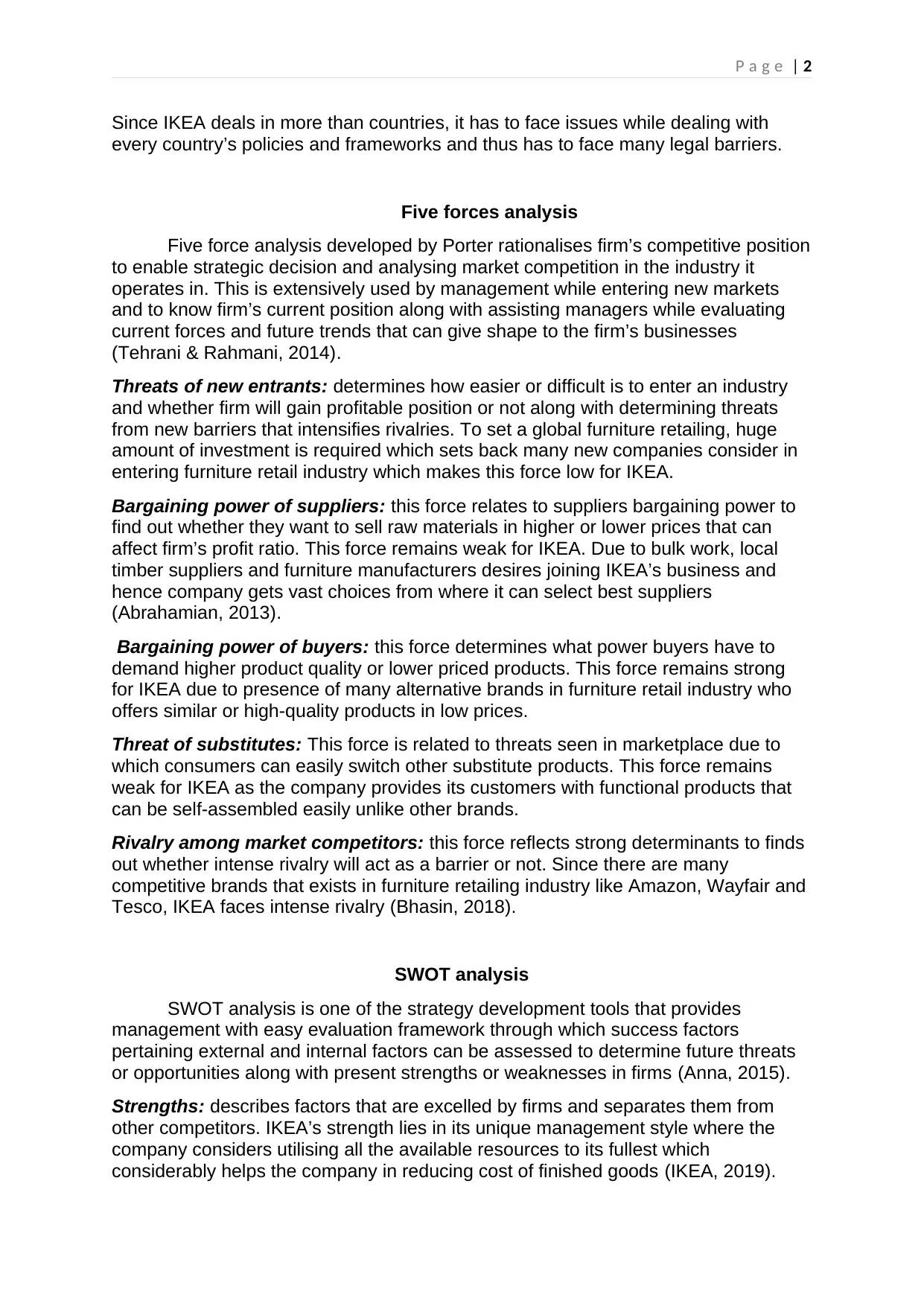
P a g e | 2
Since IKEA deals in more than countries, it has to face issues while dealing with
every country’s policies and frameworks and thus has to face many legal barriers.
Five forces analysis
Five force analysis developed by Porter rationalises firm’s competitive position
to enable strategic decision and analysing market competition in the industry it
operates in. This is extensively used by management while entering new markets
and to know firm’s current position along with assisting managers while evaluating
current forces and future trends that can give shape to the firm’s businesses
(Tehrani & Rahmani, 2014).
Threats of new entrants: determines how easier or difficult is to enter an industry
and whether firm will gain profitable position or not along with determining threats
from new barriers that intensifies rivalries. To set a global furniture retailing, huge
amount of investment is required which sets back many new companies consider in
entering furniture retail industry which makes this force low for IKEA.
Bargaining power of suppliers: this force relates to suppliers bargaining power to
find out whether they want to sell raw materials in higher or lower prices that can
affect firm’s profit ratio. This force remains weak for IKEA. Due to bulk work, local
timber suppliers and furniture manufacturers desires joining IKEA’s business and
hence company gets vast choices from where it can select best suppliers
(Abrahamian, 2013).
Bargaining power of buyers: this force determines what power buyers have to
demand higher product quality or lower priced products. This force remains strong
for IKEA due to presence of many alternative brands in furniture retail industry who
offers similar or high-quality products in low prices.
Threat of substitutes: This force is related to threats seen in marketplace due to
which consumers can easily switch other substitute products. This force remains
weak for IKEA as the company provides its customers with functional products that
can be self-assembled easily unlike other brands.
Rivalry among market competitors: this force reflects strong determinants to finds
out whether intense rivalry will act as a barrier or not. Since there are many
competitive brands that exists in furniture retailing industry like Amazon, Wayfair and
Tesco, IKEA faces intense rivalry (Bhasin, 2018).
SWOT analysis
SWOT analysis is one of the strategy development tools that provides
management with easy evaluation framework through which success factors
pertaining external and internal factors can be assessed to determine future threats
or opportunities along with present strengths or weaknesses in firms (Anna, 2015).
Strengths: describes factors that are excelled by firms and separates them from
other competitors. IKEA’s strength lies in its unique management style where the
company considers utilising all the available resources to its fullest which
considerably helps the company in reducing cost of finished goods (IKEA, 2019).
Since IKEA deals in more than countries, it has to face issues while dealing with
every country’s policies and frameworks and thus has to face many legal barriers.
Five forces analysis
Five force analysis developed by Porter rationalises firm’s competitive position
to enable strategic decision and analysing market competition in the industry it
operates in. This is extensively used by management while entering new markets
and to know firm’s current position along with assisting managers while evaluating
current forces and future trends that can give shape to the firm’s businesses
(Tehrani & Rahmani, 2014).
Threats of new entrants: determines how easier or difficult is to enter an industry
and whether firm will gain profitable position or not along with determining threats
from new barriers that intensifies rivalries. To set a global furniture retailing, huge
amount of investment is required which sets back many new companies consider in
entering furniture retail industry which makes this force low for IKEA.
Bargaining power of suppliers: this force relates to suppliers bargaining power to
find out whether they want to sell raw materials in higher or lower prices that can
affect firm’s profit ratio. This force remains weak for IKEA. Due to bulk work, local
timber suppliers and furniture manufacturers desires joining IKEA’s business and
hence company gets vast choices from where it can select best suppliers
(Abrahamian, 2013).
Bargaining power of buyers: this force determines what power buyers have to
demand higher product quality or lower priced products. This force remains strong
for IKEA due to presence of many alternative brands in furniture retail industry who
offers similar or high-quality products in low prices.
Threat of substitutes: This force is related to threats seen in marketplace due to
which consumers can easily switch other substitute products. This force remains
weak for IKEA as the company provides its customers with functional products that
can be self-assembled easily unlike other brands.
Rivalry among market competitors: this force reflects strong determinants to finds
out whether intense rivalry will act as a barrier or not. Since there are many
competitive brands that exists in furniture retailing industry like Amazon, Wayfair and
Tesco, IKEA faces intense rivalry (Bhasin, 2018).
SWOT analysis
SWOT analysis is one of the strategy development tools that provides
management with easy evaluation framework through which success factors
pertaining external and internal factors can be assessed to determine future threats
or opportunities along with present strengths or weaknesses in firms (Anna, 2015).
Strengths: describes factors that are excelled by firms and separates them from
other competitors. IKEA’s strength lies in its unique management style where the
company considers utilising all the available resources to its fullest which
considerably helps the company in reducing cost of finished goods (IKEA, 2019).
⊘ This is a preview!⊘
Do you want full access?
Subscribe today to unlock all pages.

Trusted by 1+ million students worldwide
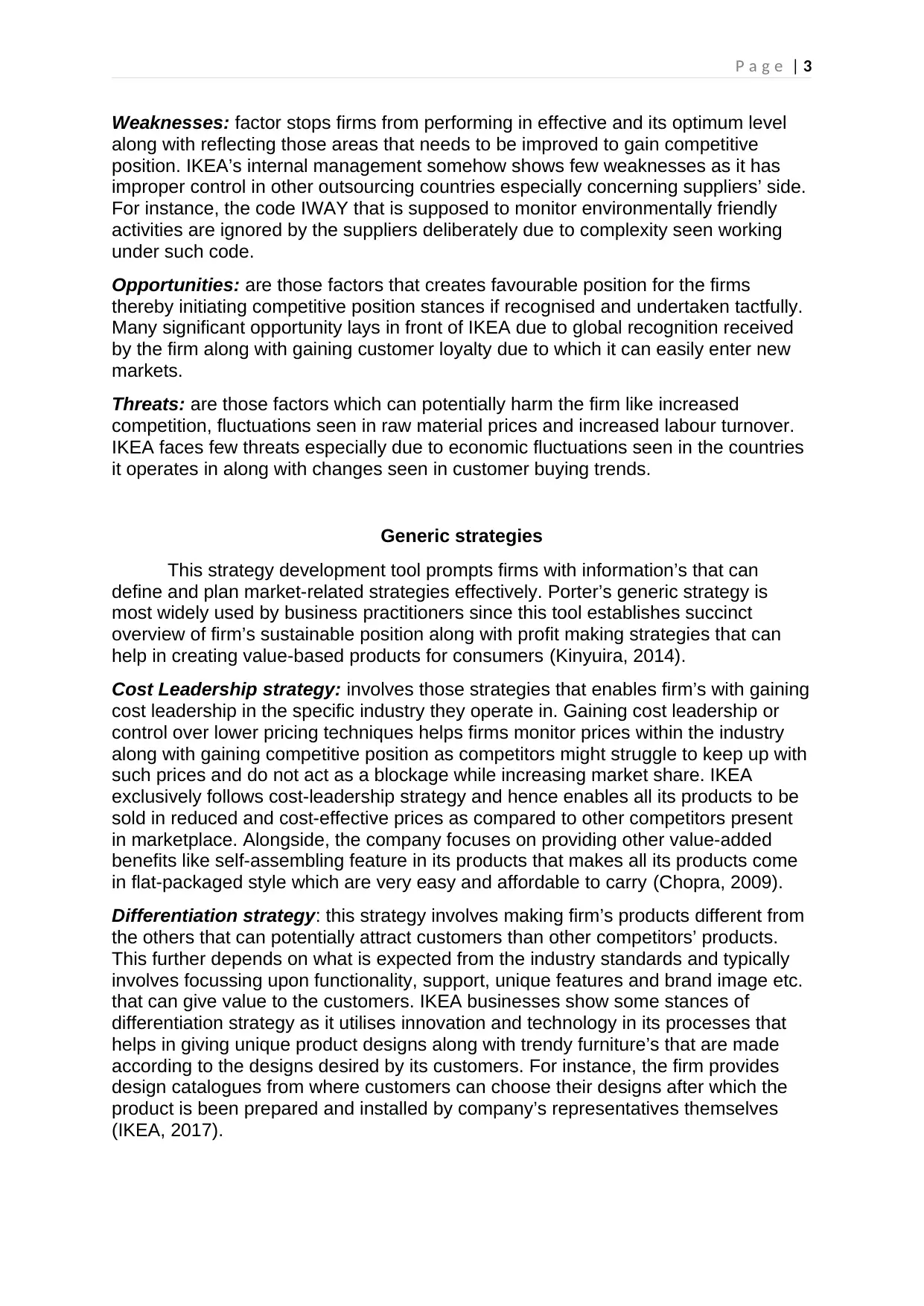
P a g e | 3
Weaknesses: factor stops firms from performing in effective and its optimum level
along with reflecting those areas that needs to be improved to gain competitive
position. IKEA’s internal management somehow shows few weaknesses as it has
improper control in other outsourcing countries especially concerning suppliers’ side.
For instance, the code IWAY that is supposed to monitor environmentally friendly
activities are ignored by the suppliers deliberately due to complexity seen working
under such code.
Opportunities: are those factors that creates favourable position for the firms
thereby initiating competitive position stances if recognised and undertaken tactfully.
Many significant opportunity lays in front of IKEA due to global recognition received
by the firm along with gaining customer loyalty due to which it can easily enter new
markets.
Threats: are those factors which can potentially harm the firm like increased
competition, fluctuations seen in raw material prices and increased labour turnover.
IKEA faces few threats especially due to economic fluctuations seen in the countries
it operates in along with changes seen in customer buying trends.
Generic strategies
This strategy development tool prompts firms with information’s that can
define and plan market-related strategies effectively. Porter’s generic strategy is
most widely used by business practitioners since this tool establishes succinct
overview of firm’s sustainable position along with profit making strategies that can
help in creating value-based products for consumers (Kinyuira, 2014).
Cost Leadership strategy: involves those strategies that enables firm’s with gaining
cost leadership in the specific industry they operate in. Gaining cost leadership or
control over lower pricing techniques helps firms monitor prices within the industry
along with gaining competitive position as competitors might struggle to keep up with
such prices and do not act as a blockage while increasing market share. IKEA
exclusively follows cost-leadership strategy and hence enables all its products to be
sold in reduced and cost-effective prices as compared to other competitors present
in marketplace. Alongside, the company focuses on providing other value-added
benefits like self-assembling feature in its products that makes all its products come
in flat-packaged style which are very easy and affordable to carry (Chopra, 2009).
Differentiation strategy: this strategy involves making firm’s products different from
the others that can potentially attract customers than other competitors’ products.
This further depends on what is expected from the industry standards and typically
involves focussing upon functionality, support, unique features and brand image etc.
that can give value to the customers. IKEA businesses show some stances of
differentiation strategy as it utilises innovation and technology in its processes that
helps in giving unique product designs along with trendy furniture’s that are made
according to the designs desired by its customers. For instance, the firm provides
design catalogues from where customers can choose their designs after which the
product is been prepared and installed by company’s representatives themselves
(IKEA, 2017).
Weaknesses: factor stops firms from performing in effective and its optimum level
along with reflecting those areas that needs to be improved to gain competitive
position. IKEA’s internal management somehow shows few weaknesses as it has
improper control in other outsourcing countries especially concerning suppliers’ side.
For instance, the code IWAY that is supposed to monitor environmentally friendly
activities are ignored by the suppliers deliberately due to complexity seen working
under such code.
Opportunities: are those factors that creates favourable position for the firms
thereby initiating competitive position stances if recognised and undertaken tactfully.
Many significant opportunity lays in front of IKEA due to global recognition received
by the firm along with gaining customer loyalty due to which it can easily enter new
markets.
Threats: are those factors which can potentially harm the firm like increased
competition, fluctuations seen in raw material prices and increased labour turnover.
IKEA faces few threats especially due to economic fluctuations seen in the countries
it operates in along with changes seen in customer buying trends.
Generic strategies
This strategy development tool prompts firms with information’s that can
define and plan market-related strategies effectively. Porter’s generic strategy is
most widely used by business practitioners since this tool establishes succinct
overview of firm’s sustainable position along with profit making strategies that can
help in creating value-based products for consumers (Kinyuira, 2014).
Cost Leadership strategy: involves those strategies that enables firm’s with gaining
cost leadership in the specific industry they operate in. Gaining cost leadership or
control over lower pricing techniques helps firms monitor prices within the industry
along with gaining competitive position as competitors might struggle to keep up with
such prices and do not act as a blockage while increasing market share. IKEA
exclusively follows cost-leadership strategy and hence enables all its products to be
sold in reduced and cost-effective prices as compared to other competitors present
in marketplace. Alongside, the company focuses on providing other value-added
benefits like self-assembling feature in its products that makes all its products come
in flat-packaged style which are very easy and affordable to carry (Chopra, 2009).
Differentiation strategy: this strategy involves making firm’s products different from
the others that can potentially attract customers than other competitors’ products.
This further depends on what is expected from the industry standards and typically
involves focussing upon functionality, support, unique features and brand image etc.
that can give value to the customers. IKEA businesses show some stances of
differentiation strategy as it utilises innovation and technology in its processes that
helps in giving unique product designs along with trendy furniture’s that are made
according to the designs desired by its customers. For instance, the firm provides
design catalogues from where customers can choose their designs after which the
product is been prepared and installed by company’s representatives themselves
(IKEA, 2017).
Paraphrase This Document
Need a fresh take? Get an instant paraphrase of this document with our AI Paraphraser
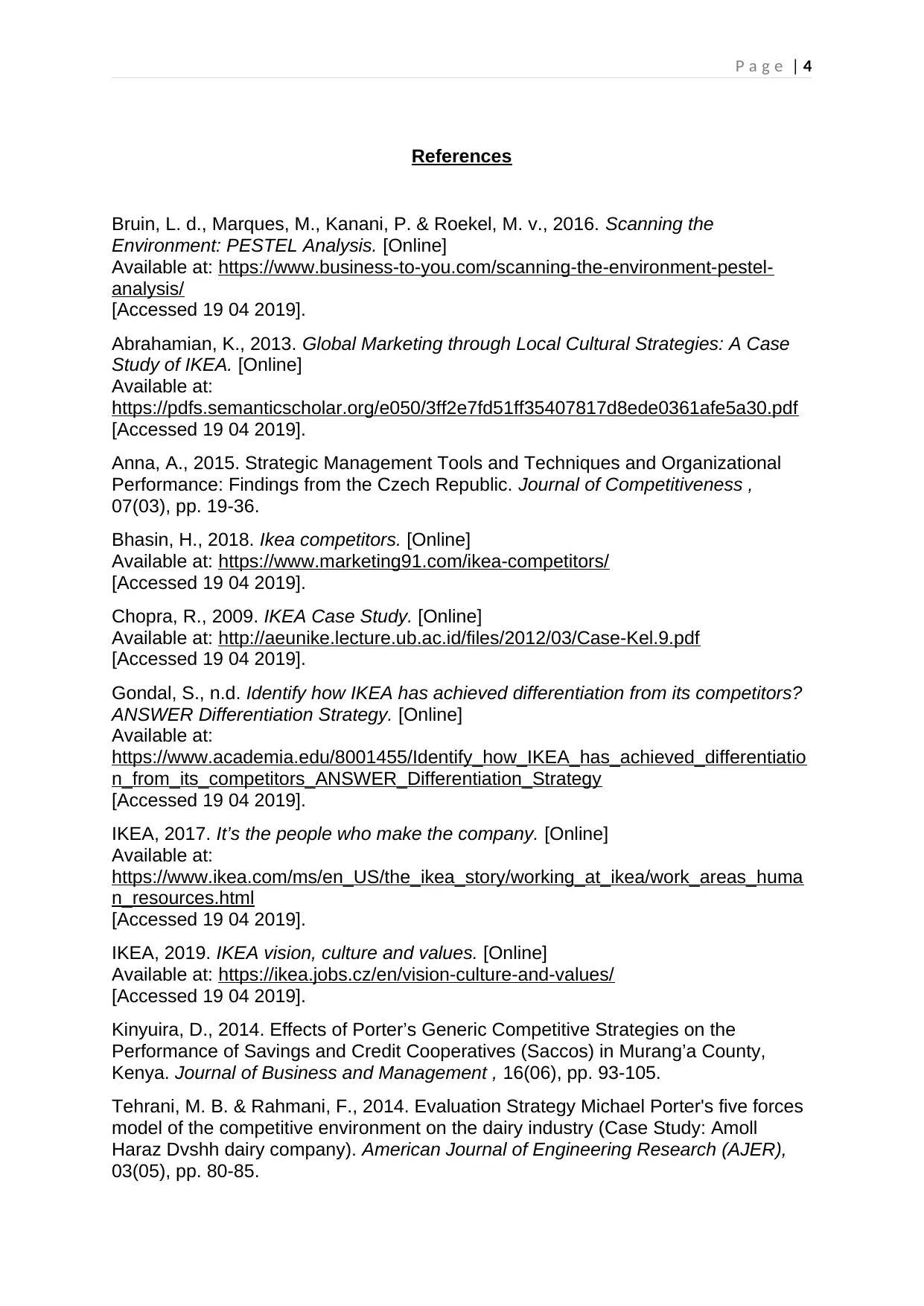
P a g e | 4
References
Bruin, L. d., Marques, M., Kanani, P. & Roekel, M. v., 2016. Scanning the
Environment: PESTEL Analysis. [Online]
Available at: https://www.business-to-you.com/scanning-the-environment-pestel-
analysis/
[Accessed 19 04 2019].
Abrahamian, K., 2013. Global Marketing through Local Cultural Strategies: A Case
Study of IKEA. [Online]
Available at:
https://pdfs.semanticscholar.org/e050/3ff2e7fd51ff35407817d8ede0361afe5a30.pdf
[Accessed 19 04 2019].
Anna, A., 2015. Strategic Management Tools and Techniques and Organizational
Performance: Findings from the Czech Republic. Journal of Competitiveness ,
07(03), pp. 19-36.
Bhasin, H., 2018. Ikea competitors. [Online]
Available at: https://www.marketing91.com/ikea-competitors/
[Accessed 19 04 2019].
Chopra, R., 2009. IKEA Case Study. [Online]
Available at: http://aeunike.lecture.ub.ac.id/files/2012/03/Case-Kel.9.pdf
[Accessed 19 04 2019].
Gondal, S., n.d. Identify how IKEA has achieved differentiation from its competitors?
ANSWER Differentiation Strategy. [Online]
Available at:
https://www.academia.edu/8001455/Identify_how_IKEA_has_achieved_differentiatio
n_from_its_competitors_ANSWER_Differentiation_Strategy
[Accessed 19 04 2019].
IKEA, 2017. It’s the people who make the company. [Online]
Available at:
https://www.ikea.com/ms/en_US/the_ikea_story/working_at_ikea/work_areas_huma
n_resources.html
[Accessed 19 04 2019].
IKEA, 2019. IKEA vision, culture and values. [Online]
Available at: https://ikea.jobs.cz/en/vision-culture-and-values/
[Accessed 19 04 2019].
Kinyuira, D., 2014. Effects of Porter’s Generic Competitive Strategies on the
Performance of Savings and Credit Cooperatives (Saccos) in Murang’a County,
Kenya. Journal of Business and Management , 16(06), pp. 93-105.
Tehrani, M. B. & Rahmani, F., 2014. Evaluation Strategy Michael Porter's five forces
model of the competitive environment on the dairy industry (Case Study: Amoll
Haraz Dvshh dairy company). American Journal of Engineering Research (AJER),
03(05), pp. 80-85.
References
Bruin, L. d., Marques, M., Kanani, P. & Roekel, M. v., 2016. Scanning the
Environment: PESTEL Analysis. [Online]
Available at: https://www.business-to-you.com/scanning-the-environment-pestel-
analysis/
[Accessed 19 04 2019].
Abrahamian, K., 2013. Global Marketing through Local Cultural Strategies: A Case
Study of IKEA. [Online]
Available at:
https://pdfs.semanticscholar.org/e050/3ff2e7fd51ff35407817d8ede0361afe5a30.pdf
[Accessed 19 04 2019].
Anna, A., 2015. Strategic Management Tools and Techniques and Organizational
Performance: Findings from the Czech Republic. Journal of Competitiveness ,
07(03), pp. 19-36.
Bhasin, H., 2018. Ikea competitors. [Online]
Available at: https://www.marketing91.com/ikea-competitors/
[Accessed 19 04 2019].
Chopra, R., 2009. IKEA Case Study. [Online]
Available at: http://aeunike.lecture.ub.ac.id/files/2012/03/Case-Kel.9.pdf
[Accessed 19 04 2019].
Gondal, S., n.d. Identify how IKEA has achieved differentiation from its competitors?
ANSWER Differentiation Strategy. [Online]
Available at:
https://www.academia.edu/8001455/Identify_how_IKEA_has_achieved_differentiatio
n_from_its_competitors_ANSWER_Differentiation_Strategy
[Accessed 19 04 2019].
IKEA, 2017. It’s the people who make the company. [Online]
Available at:
https://www.ikea.com/ms/en_US/the_ikea_story/working_at_ikea/work_areas_huma
n_resources.html
[Accessed 19 04 2019].
IKEA, 2019. IKEA vision, culture and values. [Online]
Available at: https://ikea.jobs.cz/en/vision-culture-and-values/
[Accessed 19 04 2019].
Kinyuira, D., 2014. Effects of Porter’s Generic Competitive Strategies on the
Performance of Savings and Credit Cooperatives (Saccos) in Murang’a County,
Kenya. Journal of Business and Management , 16(06), pp. 93-105.
Tehrani, M. B. & Rahmani, F., 2014. Evaluation Strategy Michael Porter's five forces
model of the competitive environment on the dairy industry (Case Study: Amoll
Haraz Dvshh dairy company). American Journal of Engineering Research (AJER),
03(05), pp. 80-85.
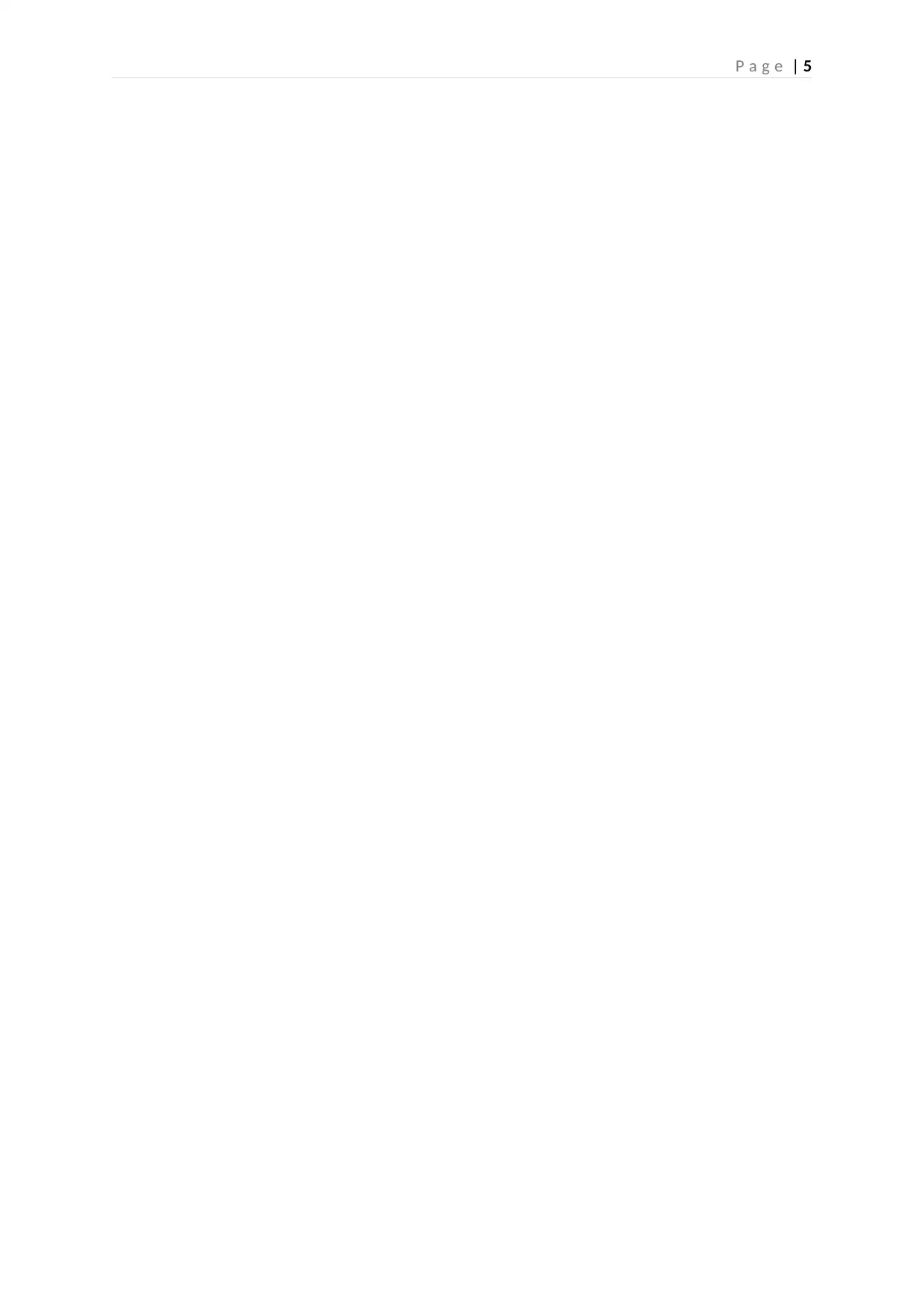
P a g e | 5
⊘ This is a preview!⊘
Do you want full access?
Subscribe today to unlock all pages.

Trusted by 1+ million students worldwide
1 out of 6
Related Documents
Your All-in-One AI-Powered Toolkit for Academic Success.
+13062052269
info@desklib.com
Available 24*7 on WhatsApp / Email
![[object Object]](/_next/static/media/star-bottom.7253800d.svg)
Unlock your academic potential
Copyright © 2020–2025 A2Z Services. All Rights Reserved. Developed and managed by ZUCOL.




